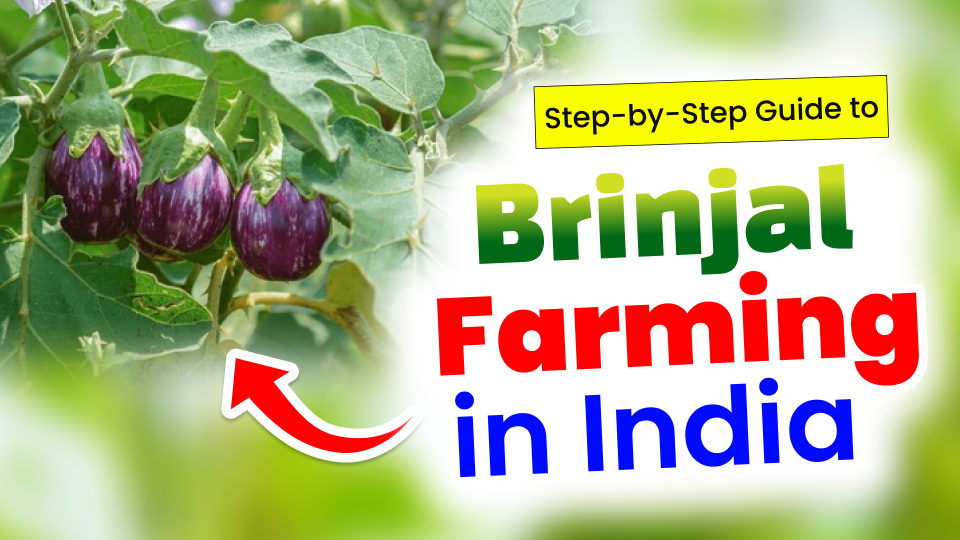
Brinjal, also known as eggplant or aubergine, is a widely cultivated and consumed vegetable in India. Known for its versatility in cooking and rich nutritional profile, brinjal is a staple in many Indian households. Brinjal cultivation offers farmers significant economic benefits due to its relatively short growing season and high market demand. This comprehensive guide explores various aspects of brinjal farming in India, providing essential information for successful cultivation.
Brinjal Crop at a Glance
- Biological Name: Solanum melongena
- Cropping Season: The brinjal growing season in India is throughout the year.; the main seasons are Kharif (June-July) and Rabi (October-November)
- Crop Type: Annual vegetable crop
- Production: India is one of the largest producers of brinjal
- Consumption: Consumed as a vegetable in various forms such as fried, baked, roasted, or in curries
- Export: Brinjal is exported to countries in the Middle East, Europe, and Asia
Types of Brinjal in India
India cultivates a wide range of brinjal varieties, each adapted to different climatic conditions and consumer preferences. Some popular varieties include:
- Pusa Purple Long: Long, purple fruits; suitable for North Indian plains.
- Arka Nidhi: Oval, purple fruits; high-yielding variety.
- Green Round: Round, green fruits; popular in South India.
- Arka Shirish: Resistant to bacterial wilt; high yielding.
- Pusa Kranti: Round, dark purple fruits; good for both Kharif and Rabi seasons.
Required Climatic Conditions
The brinjal plant thrives in warm climates and requires specific conditions for optimal growth:
- Temperature: Ideal range is 25°C to 35°C.
- Rainfall: Requires moderate rainfall; excessive moisture can lead to fungal diseases.
- Sunlight: Needs full sunlight for at least 6-8 hours daily.
Soil Requirement
- Type: Well-drained loamy soil is ideal.
- pH Level: Slightly acidic to neutral (6.0 to 7.0).
- Nutrient Content: Rich in organic matter with balanced nutrients.
Land Preparation
Depending on the soil type, prepare the land by ploughing once or twice. Mix 3 tons of Farm Yard Manure (FYM) and 3 Liter of composting bacteria in the field, allowing it to decompose in open air for 10 days. Spread this mixture evenly over the soil and use a rotavator to achieve a fine tilth throughout the field. Prepare raised beds, 90 – 120 cm wide bed preparation, by using a tractor.
Sowing
- Method: Seeds are sown in nurseries and brinjal seedlings are transplanted to the main field.
- Timing: Kharif season (June-July) and Rabi season (October-November).
Seed Rate
- Quantity: Approximately 100 – 150 grams of seeds per hectare.
- Quality: Use certified seeds for better germination and disease resistance.
Variety
Brinjal, also known as eggplant, is a popular vegetable in India with a variety of types cultivated across different regions. Here are some common types:
- Pusa Purple Long: Known for its long, slender fruits, this variety is widely grown in North India.
- Arka Nidhi: A high-yielding hybrid variety with medium-sized, round fruits. It is resistant to several pests and diseases.
- Green Long: This variety features long, cylindrical fruits with a green skin and is popular in southern states.
- Bangalore Brinjal: Characterized by its large, oval-shaped fruits with a deep purple color, commonly grown in Karnataka.
- White Brinjal: Known for its creamy white skin, this variety is less common but valued for its unique flavor and texture.
- Bharta Brinjal: This type is ideal for making “Baingan Bharta” due to its large, round fruits with purple and green stripes.
Each variety offers distinct flavors, shapes, and sizes, catering to diverse culinary preferences across the country.
Seed Treatment
For effective seed treatment, use Thiamethoxam 30% FS at 10 ml / kg seed to protect against sucking pests. Combine with Carbendazim 50% WP at 3 gm / kg seed to prevent fungal diseases. This dual treatment ensures healthier germination and robust plant growth.
Nursery Preparation
There are two methods of nursery preparation mentioned below:
Method 1:
For transplanting in a 1-acre area, a nursery of 0.1 acre (4 Guntha) is needed. Prepare four beds measuring 7.2 m in length, 1.2 m in width, and 10 cm in height. Sow seeds in lines 5 cm apart and cover them with soil. Water the nursery beds twice daily until germination, then once daily afterward. Reduce water application ten days before transplanting to harden the brinjal seedlings. Three days post-germination, drench the seedbed with Ridomil (20 gms in 10 liters of water) to prevent damping-off disease. At 25 days after sowing, spray a solution of 19:19:19 (5 gm) and Thiamethoxam (0.25 gm) per liter of water.
Method 2:
Fill pro trays with cocopeat at a rate of 1.2 kg per tray. Sow treated seeds in the trays, one seed per cell. Cover the seeds with cocopeat and stack the trays, covering them with a polythene sheet until germination begins (5 days). After 6 days, place the trays with germinated seeds individually on raised beds inside a shade net.
Spacing
- Row Spacing: Maintain a distance of 90-120 cm between rows.
- Plant Spacing: 45-60 cm between plants within a row.
Nutrient Management
- NPK Fertilization: Apply 100 kg of nitrogen (N), 75 kg of phosphorus (P), and 50 kg of potassium (K) per acre.
- Basal Dose Application: Incorporate a basal dose of NPK at 50 kg of nitrogen, 75 kg of phosphorus, and 50 kg of potassium per hectare during initial soil preparation.
- Top Dressing: Administer an additional 50 kg of nitrogen per acre as a top dressing 30 days after planting, or during the earthing up process.
Irrigation Management
- Frequency: Regular irrigation is crucial, especially during flowering and fruiting stages.
- Methods: Drip irrigation is highly recommended for efficient water use and uniform distribution.
- Water Management: Avoid waterlogging; ensure proper drainage.
Intercultural Operations
- Weeding: Regular weeding is essential to reduce competition for nutrients and moisture.
- Thinning: Thin seedlings to maintain the recommended plant population.
- Mulching: Apply organic mulch to conserve moisture and control weeds.
Crop Protection
Crop protection includes pest and disease management. Below are the pests and diseases that affect Brinjal crops.
Pest Management
Leaf miner
Leaf miners are larvae that feed on the mesophyll tissue within leaves, creating irregular mines that may become necrotic. They can also tunnel into stems, hindering plant development, and sometimes attack the fruit as well.
Organic Control: Spray Neem oil @ 2 ml per lit water
Chemical Control: Spray Abamectin 1.9% EC – 0.5 ml OR Thiamethoxam 25% WG – 0.5 gm OR Cartap Hydrochloride 50% SP – 1.5 gm per liter water.
Sucking Pest – Thrips, Aphid, Whitefly, Jassids
In Brinjal crop, sucking pests like thrips, aphids, and whiteflies suck the leaf sap, weakening the plants and leading to stunted growth and reduced yields.
Mechanical Control: Install Yellow and Blue sticky traps @ 10 per acre
Organic Control: Spray Neem oil @ 2 ml per lit water
Chemical Control: Spray Acetamiprid 20% SP – 0.5 gm OR Thiamethoxam 25% WG – 0.5 gm OR Dimethoate 30% EC 2 ml OR Imidacloprid 17.8% SL – 0.5 ml per liter
Fruit and Shoot Borer
The larva penetrates young shoots, leading to the wilting of terminal shoots or dead hearts. It also tunnels into leaf petioles, flower buds, and developing buds, resulting in leaf wilting, bud drop, and rendering fruits unsuitable for consumption.
Mechanical Control: Install 4-5 Fruit borer traps per acre in the field.
Chemical Control: Spray Emamectin benzoate 5% SG – 0.5 gm OR Chlorantraniliprole 18.5% SC – 0.4 ml OR Ampligo insecticide 0.5 ml OR Gracia Insecticide 1 ml per liter water.
Nematode
Symptoms include premature leaf fall, wilting and decline in growth and fruit production. Roots of infected plants show typical galls / knots.
Organic Control: Drench Paecilomyces Lilacinus @ 2 lit per acre.
Chemical Control: Drench Bayer Velum Prime – 300 ml per acre.
Red Mite
Nymphs and adult insects feed on plant sap, causing white patches to appear on the leaves. Affected foliage becomes mottled, eventually turning brown and dropping from the plant.
Chemical Control: Spray Diafenthiuron 50 % WP – 1 gm OR Propargite 57 % EC – 2.5 ml OR Spiromesifen 22.9 % SC 1 ml per liter water.
Disease Management
The following disease are harmful to Brinjal farming and directly affect the yield of the Brinjal crop.
Alternaria Leaf Blight
Small, yellow-brown spots with a yellow or green halo initially appear on the oldest leaves.
Chemical Control: Spraying of Ridomil Gold @ 2 gram OR Antracol (Propineb)@ 2.5 gram per liter water.
Cercospora Leaf Spot
The disease initially manifests as small spots with light to tan brown centers on older leaves. As it progresses, these lesions enlarge, covering significant portions of the leaf surface.
Chemical Control: Spray saaf fungicide @ 2 gm OR Curzet @ 2.5 gm/liter water.
Bacterial Wilt
Symptoms of bacterial wilt include wilting, stunting, yellowing of foliage, and ultimately the collapse of the entire plant, marking the disease’s distinctive characteristics.
Organic Control: Drench biofungicide Pseudomonas Fluorescens 500 gm per acre.
Chemical Control: Drench fungicide Copper Oxychloride 50% WP 500 gm + Plantomycine 100 gm per acre.
Tobacco mosaic virus (TMV)
Tobacco mosaic virus, spread by Aphids, poses a significant threat to brinjal crops. The disease symptoms include mottling of leaves, stunted plant growth, and reduced yields.
Mechanical Control: Install Blue sticky traps @ 10 per acre.
Organic Control: Spray Neem oil @ 2 ml per liter water
Chemical Control: Spray Geolife No Virus 3 ml with Thiamethoxam 25% WG – 0.5 gm OR Imidacloprid 17.8% SL 0.5 ml OR Fipronil 5 % SC 2 ml per liter water.
Little leaf of Brinjal
The distinct symptom is the reduced size of the leaves, with short petioles causing them to appear tightly attached to the stem. Flowering is typically absent, and if flowers do develop, they often remain green. Fruit production is infrequent under these conditions.
Chemical Control: Spray Geolife No Virus 3 ml with Fipronil 5% SC – 2 ml OR Imidacloprid 17.8% SL 0.5 ml per acre.
Fusarium Wilt
Infected plants may display dark brown or reddish-brown discoloration in the vascular tissue when the stem is cut open. This symptom is often accompanied by stunted growth, eventually leading to plant death.
Organic Control: Drench biofungicide Trichoderma viride 500 gm per acre.
Chemical Control: Metalaxyl 8% + Mancozeb 64% WP – 500 gm OR Thiophanate methyl 70 % WP 400 gm per acre.
Harvesting
- Timing: Brinjal crop duration ranges from 120 to 180 days, depending on the variety and cultivation practices. Brinjal harvesting time is when the fruits reach full size and are tender, usually 50-60 days after transplanting.
- Frequency: Harvest every 2-3 days during the peak season.
Yield
- Average Yield: Average Brinjal yield per acre is 10-12 tonnes.
- High Yield: With improved practices, yields can reach up to 16 tonnes per acre.
Conclusion
In conclusion, brinjal farming is a lucrative venture with significant economic potential. By following the recommended practices for soil preparation, nutrient management, pest control, and timely harvesting, farmers can achieve high yields and quality produce. Brinjal’s adaptability to various climatic conditions and its nutritional benefits make it a valuable crop in Indian agriculture.
FAQs
The best seasons are Kharif (June-July) and Rabi (October-November)
Well-drained loamy soil with a pH of 6.0 to 7.0 is ideal.
Brinjal requires moderate irrigation, with increased frequency during flowering and fruiting stages.
Common pests include shoot and fruit borers, aphids, and whiteflies.
Brinjal is handpicked when fruits reach full size and are tender, usually 50-60 days after transplanting.



